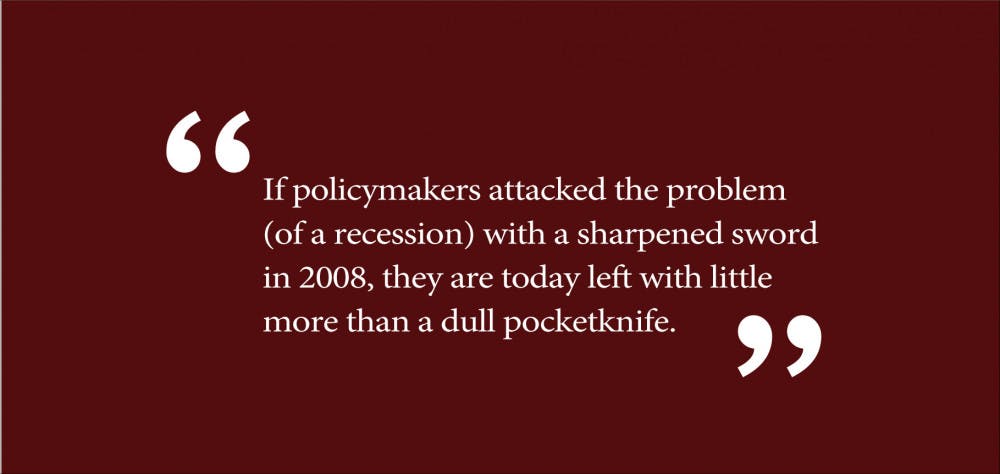January 2008. Markets were in free fall as confidence in long-trusted yet misunderstood financial instruments had eroded. American communities entered a taxing saga defined by unemployment, chaos and class conflict. The Federal Reserve’s framework for crisis response would be subjected to the toughest test it had faced since the Great Depression.
Twelve years on, with the worst of the disaster over, that framework seems to have beaten back the downturn using what is arguably the most important tool that the Fed possesses: monetary policy, or the ability to directly control the quantity of money distributed and indirectly control interest rates by influencing supply and demand. When the supply of money increases, it becomes less scarce — so interest rates (the “price” that we pay to borrow money) go down. A decrease in the money supply, on the other hand, has the opposite effect of driving up interest rates.
For the Federal Reserve, a quasi-governmental organization dedicated to protecting economic stability, power over interest rates means the power to combat recessions. At the end of 2008, the federal funds rate was just above 0 percent compared to its pre-crisis level of 5 percent. The lower interest rate made it easier for consumers to buy new homes, gave businesses opportunities for expansion, drove spending in an economy that desperately needed it and ballooned the money supply by about $4 trillion to make that all possible. Interest rates are clearly an effective way to fight contractions. When the next recession hits — and it could be sooner rather than later — the Federal Reserve will look to lower interest rates to combat it.
But what if interest rates can’t go any lower?
Going forward, that is precisely the challenge that policymakers will have to reckon with; rates are so low that monetary policy has become ineffective in steering the economy. Interest rates in America remain low — they vary between 1.5 percent and 1.75 percent. Even if the Federal Reserve were to follow Japan’s lead and allow rates to dip slightly below 0 percent, there is, mathematically, a limit to how low rates can go in the event of a recession. If policymakers attacked the problem with a sharpened sword in 2008, they are today left with little more than a dull pocketknife — an instrument that cannot hope to cut interest rates to the degree that former Federal Reserve Chairman Ben Bernanke argues would be necessary for monetary policy to be effective in the event of a crisis.
That leaves the United States highly vulnerable to recession in the near future, especially considering that the Federal Reserve has been reluctant to raise rates. Just last month, the organization’s leadership, hesitant to rock the economic boat, promised not to increase rates during 2020.
But the Federal Reserve isn’t the only actor keeping interest rates low — the average American also plays a role. Consumers are saving more and more of their incomes — 17 percent more in 2018 alone — which drives down interest rates even further on both the supply side and the demand side. On the supply side, more money saved means more money lying dormant in bank accounts. With more cash to loan out, banks drive up the supply of loanable funds and put downward pressure on interest rates. From the other end, because Americans are saving more, they’re necessarily buying less. This means that there is less demand for loans to purchase credit-dependent goods such as cars and homes, which further lowers interest rates.
The trend of decreasing interest rates is amplified by demographic changes that are becoming harder and harder to ignore. Older people tend to save more, intensifying the market forces that are already pulling interest rates downward. And the median age in America has increased by about 10 years since 1960; while America is greying, it is saving more and spending less.
This “liquidity trap” — a situation defined by low interest rates and stubborn saving habits — could be addressed with policy novelties. Helicopter money, for instance, is a proposed monetary policy arguing that government can encourage people to spend more by literally gifting newly created money to citizens. In other words, the Fed would distribute cash universally, as if dropping it from a helicopter — allowing it to move throughout the economy.
Nonetheless, a lack of easy solutions means that, ultimately, investors and consumers alike should not count on a smooth resolution to a hypothetical recession. In 2008, struggling consumers could count cheap credit among their relatively few blessings. The ability to purchase a variety of goods for cheap helped both to get them back on their feet and to give stagnant businesses the revenue they needed to start expanding again. Spooked investors gradually regained their footing post-2008 and share prices rose as part of one of the longest bull markets in American history. This was made possible largely by steep rate cuts and the Federal Reserve’s practice of “forward guidance” — regular communications about the future of monetary policy to allow investors to plan financially. When macroeconomic fundamentals next begin to wobble, middle-class Americans and Wall Streeters alike ought to be prepared for a recession that will likely prove tough to resolve.
Forecasting economic downturn is an imperfect science. A better bet is to be prepared to weather a prolonged storm at any time, lest policymakers find their bag of tricks inadequate in the face of crisis.
Arjun Shanmugam ’23 can be reached at arjun_shanmugam@brown.edu. Please send responses to this opinion to letters@browndailyherald.com and op-eds to opinions@browndailyherald.com.



